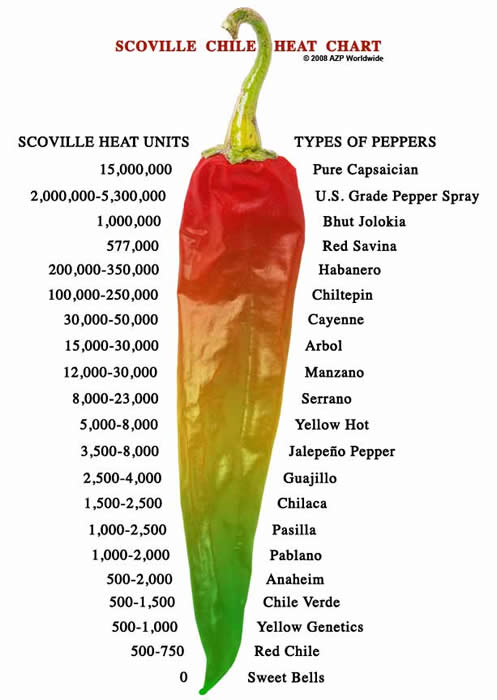Bill, my father-in-law usually has a whole, raw serrano chile within arms reach during most meals. He is well versed in the varieties and scoville ratings of chiles and I have yet to stump him on any original brand of hot sauce out there. He does endure the heat and I believe he enjoys these fruits for their varied flavor.
His appreciation and palate is obvious when I eat his guacamole. One might think that a simple recipe like guacamole would be a trivial way to judge a deft hand of layering flavor but then one has not had his. I have.
I wanted to make a vinegar that was hot but that also embodied the fruity flavors of the chiles I would be using. I could want and wish but just like my pear vinegar nature would ultimately dictate the end result.
I put cloves of garlic, chunks of fresh ginger and 5 varieties of chile peppers (habanero, arbol, jalapeno, serrano and red bell peppers) into a glass crock with filtered water, covered it with a bandanna and hid it from the light.
 |
| Chile vinegar. Only 4. Bottled on 10/31/2012. Halloween! |
I could not believe the aroma that emitted from the crock in less than a day. I felt like I was standing outside the back door of a Mexican restaurant. Such a warm and pungent odor. Foods like refried beans, Spanish rice and heavy, long stewed sauces came to my mind every time I was remotely close. At times it was almost embarrassing as if I was producing an unmentionable tonic which smelled similar to it's symptom. And at times it was just too rich of an odor but quite the sensory experience. I could just imagine foods being fried and sauced rich and spicy. Finally a milky, silk-like mother made a home and the intense odor subsided and the acid began to cleanse the air.
Once a good acid base had set I skimmed the mother and added toasted annatto seeds, red chile flakes and apple wood. I sealed this and let it age for 3 weeks before pasteurizing and bottling. And timing couldn't have been better for I was able to bottle it on Halloween. Perfect!
I had set out to make just a little and that is essentially what I was left with. 4 bottles. As I was preparing to bottle I originally wanted to filter the mixture to rid the vinegar of the pureed chiles and seasonings. However as I blended the mixture, tasting along the way I realized I would be throwing away not only flavor and body but the elements of the vinegar that would continue to age and lend character as it aged in the bottle. So I used a fine mesh strainer to remove any unpalatable pieces.
Sure this would lead to a large amount of sediment in the bottle but this would become part of the experience for those who were able to enjoy it. Whether one wishes to pour the vinegar off the top and savor the sediment or shake it before use and enjoy it all now. It is up for debate. Just enjoy it!
Here is the official description:
.jpg) |
| Chile Vinegar. October 31, 2012. |
Method: The ingredients were thoughtfully chosen, combined and left to ferment in the traditional Orleans Method of fermentation. Over time, nature developed the flavor and acidity until just right, at which point, the vinegar was sealed as a single batch and allowed to mellow with toasted anatto seeds and apple wood from 2 to 4 weeks before it was strained, pasteurized, and bottled.
Spoiled Rotten Chile, Batch #1 2012: Fruity acidity of chiles finishing with a pleasantly aggressive heat.
 |
| Shadow Creek's Spoiled Rotten Vinegars to date. |
De glaze for Sauteed Greens
yields enough greens for 2 side portions
*Beet greens, mustard greens, swiss chard and lacinato kale (dino) are great chopped up and sauteed.
Ingredients:
1 teaspoon garlic, minced
2 Tablespoons shallot, minced
1-2 Tablespoons Spoiled Rotten Chile or Maple Vinegar
1 to 2 bunches of hearty greens mentioned above. I am a purist but mixing varieties is good too. Wash, de-stem and prep. I chop leafy parts up and slice the stems thinly. Stems tend to be fibrous so slicing thinly against grain is best. *Keep stems and greens separate*
Method:
In a hot saute pan heat 1-2 Tablespoons oil.
Add garlic and shallot. Saute stirring frequently until starting to brown lightly.
Add stems and saute for 1 min.
Add greens and saute for 3 min. or until wilted and softened.
Season now with salt and pepper.
drizzle in Spoiled Rotten Chile or Maple vinegar (1-2 Tablespoons) to de glaze.
Allow vinegar to absorb and reduce.
Eat

No comments:
Post a Comment